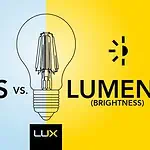Lighting plays a crucial role in a space’s ambiance, whether at home, in an office, or in a public place. When purchasing light bulbs, it’s essential to understand the differences between the terms “lumens” and “kelvin” to make an informed decision.
The main difference between kelvin and lumens is that kelvin denotes or is responsible for the color of the light produced by a light bulb. On the contrary, lumens are the brightness of that colored light that the light bulb produces. While Kelvin defines light color, lumens tell how bright that light will be.
Understanding these two terms’ distinctions can help you choose the correct bulb to create the desired atmosphere and improve energy efficiency. In this blog, we’ll dive into the differences between kelvin and lumens and their significance in selecting the correct light bulb for your needs.
Kelvin Explained
Variety temperature shows the presence of the illumination of the lighting installation. This impression of light is estimated in Kelvin (K) and is assessed to be inside 1,000 to 10,000. The range of the bulbs utilized in business and local locations goes from 2000 K to 6500 K.
The variety of light surfaces shows the look conveyed while illuminating it. Assigning the bulbs’ variety temperature uses the associated variety temperature hypothesis (CCT). For instance, the presence of light can be obtained after warming metals at high temperatures.
Temperature changes adjust the variety of appearance of the metal, similar to blue, orange, or yellow. Be that as it may, the inside science of the lights deals with specific examples of the metallic substance thinking about the Kelvin temperature.

- The color temperature from 2000 K to 3000 K is known as “warm white.”
- The apparent nature of the light shows up to some degree between orange to yellow-white. Then again, if the variety temperature fluctuates between 3100 K and 4500 K is classified as “warm white.”
The transmitted light appeared to be tinted blue or clear neutral white. The variety temperature over 4500 K is designated “cool daylight.” Regardless, the motivation to title it “daylight” is because the light imitates light and subsequently gives a blue-white lighting highlight.
The variety temperature of 2700 K is viewed as best for family rooms, feasting regions, kitchens, and even rooms. Then again, 3000 K can be considered reasonable for rooms and open-air spaces. Additionally, 5000 K or more is best for illuminating garages and basements.
More information, you can read
How to Choose LED Strip Color Temperature?
Best Color Temperature for LED Office Lighting
Lumens Explained
Lighting apparatuses are constantly obtained after checking their brilliance. Lumens gauge the splendor limit of the lighting installations. “Lumen” signifies light, and it’s moderately perceptible when somebody attempts to set the similitude with lights. Be that as it may, estimating the sum and limit of LED lights set forward is known as lumen. The more the lumen, the more splendid the lighting apparatuses will be.
It’s fundamental to realize how much power the LED consumes or about the lumen. Both are critical in their places. In any case, it’s essential to look at the phenomenon of the light before getting it. To decide the power of the conventional bulbs, “wattage” was thought of. Wattage demonstrates the power utilization limit of the light. Then again, it improved the information on the brilliance of the apparatuses. Better wattage indicates more brilliant light.
However, the idea of magnificence and power utilization assumption has changed with various productive lighting open doors. Besides, wattage exhibits nothing about the brilliance of the light, as lumens have the proficiency in outlining this subject.
By working out the lumens, one can rapidly decide the all-out piece of the lights educated per square foot. For instance, a standard bulb can convey 1600 lumens conversely, with 100 watts, while a LED can achieve similar lumens with 26 watts. That is the reason LEDs are liked over glowing bulbs.
More information, you can read
Lumen to Watts: The Complete Guide

Lumens Vs. Kelvin- How Are They Different?
In short, lumens measure the brightness of a light bulb, while kelvin measures the color temperature of the light. Both are important considerations when choosing a bulb for a particular use, but they serve different purposes.
| Lumens | Kelvin |
| Measures brightness | Measures color temperature |
| Indicates how much light a bulb emits | Indicates the hue of the light emitted by a bulb |
| Higher lumens mean a brighter bulb | Higher kelvin means a cooler, bluer light |
| Important for choosing the right level of brightness for a room or task | Important for creating a specific mood or ambiance |
| Affects energy efficiency and cost | Affects how objects and colors appear under the light |
| Can vary based on bulb type, wattage, and design | Can vary based on personal preference and intended use |
Correlation Between Lumen & Kelvin- A Myth
Lumens and Kelvin are connected; it’s known to everybody! Indeed, that is a misguided judgment. There is a correlation between lumen and Kelvin, but it is not a direct correlation.
A higher number of lumens does not necessarily mean a higher Kelvin temperature and vice versa. However, the color temperature of light can affect how bright it appears to the human eye. For example, a cool, bluish light may appear brighter to the eye than a warm, yellowish light with the same number of lumens.

What’s Important When Buying A Bulb- Kelvin Or Lumen?
When buying a bulb, both Kelvin and Lumen are essential factors to consider. Kelvin (K) is a measure of the color temperature of the light, while Lumen (lm) is a measure of the brightness of the light.
Kelvin is important because it affects the ambiance and mood of the room. Bulbs with lower Kelvin values (2700K-3000K) produce a warm, cozy, yellowish light that is perfect for bedrooms, living rooms, and dining areas. Bulbs with higher Kelvin values (3500K-5000K) produce a cooler, brighter, bluish-white light better suited for workspaces, kitchens, and bathrooms.
Lumen is crucial because it determines the brightness of the light. The higher the lumen rating, the brighter the light. The amount of lumens you need will depend on the room’s size and the light’s purpose. For example, a reading lamp may only need 300-500 lumens, while a large living room may need 1500-3000 lumens.

FAQs
Kelvin is a measurement unit used to describe a light source’s color temperature. It is commonly used to classify the color appearance of white light, with lower numbers representing warm or yellowish tones and higher numbers representing cool or bluish tones.
A lumen is a unit of measurement used to describe the amount of visible light emitted by a light source. It is used to indicate the brightness of a bulb or fixture, with higher lumens meaning a brighter light output.
While Kelvin and Lumens both describe different characteristics of a light source, they are related in that the color temperature (Kelvin) of a light can affect its perceived brightness (Lumens).
Yes, a light source’s color temperature can significantly impact the mood and ambiance of a room. Warmer, lower Kelvin bulbs can create a cozy and inviting atmosphere, while cooler, higher Kelvin bulbs can provide a bright and energetic feel.
There is no one “right” Kelvin temperature for a home, as personal preferences and specific uses of lighting may vary. However, many people prefer warmer, lower Kelvin bulbs for areas where relaxation and comfort are important, such as bedrooms and living rooms.
No, the brightness of a light source is measured in Lumens, not Kelvin. While higher Kelvin bulbs may appear brighter due to their cooler, bluish tone, the bulb’s actual brightness is determined by its lumen output.
Yes, a light source’s color temperature can impact the perceived color accuracy of objects in a room. Cooler, higher Kelvin bulbs can make colors appear more vibrant, while warmer, lower Kelvin bulbs may make colors appear duller.
“Warm white” bulbs typically have a lower Kelvin temperature (around 2700K-3000K) and emit a warm, yellowish light that can create a cozy and inviting atmosphere. “Cool white” bulbs typically have a higher Kelvin temperature (around 4000K-5000K) and emit a cooler, bluish light that can provide a bright and energetic feel.
Lower Kelvin bulbs (around 2700K-3000K) are commonly used in areas where relaxation and comfort are essential, such as bedrooms and living rooms. Higher Kelvin bulbs (around 4000K-5000K) are commonly used in areas where task lighting and productivity are essential, such as kitchens and offices.
Yes, many modern light fixtures have adjustable Kelvin and Lumen settings that allow users to customize the color temperature and brightness of the light output. Some fixtures may even have “smart” features that allow users to adjust settings via a mobile app or voice assistant.

Conclusion
In conclusion, understanding the differences between Kelvin and lumens is essential for making informed lighting choices. While lumens measure the brightness of a bulb, Kelvin determines the color temperature. A higher Kelvin rating means the light will appear cooler, while a lower rating will appear warmer. Depending on your needs, you may want to choose a bulb with a specific Kelvin rating or lumens level. By keeping these factors in mind, you can ensure that you select the proper lighting for your home, office, or any other space.
LEDYi manufactures high-quality LED strips and LED neon flex. All of our products go through high-tech laboratories to ensure the utmost quality. Besides, we offer customizable options on our LED strips and neon flex. So, for premium LED strip and LED neon flex, contact LEDYi ASAP!




